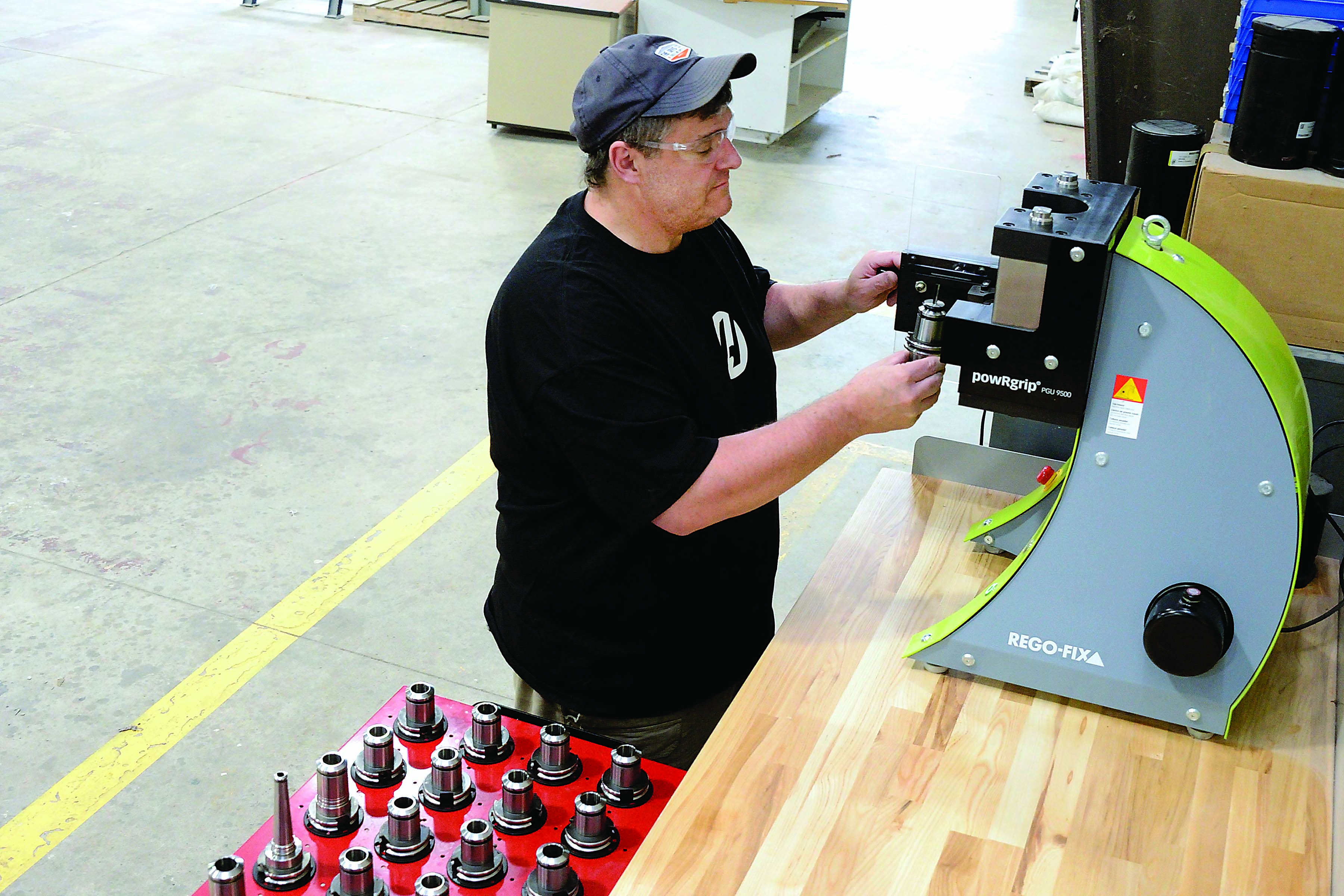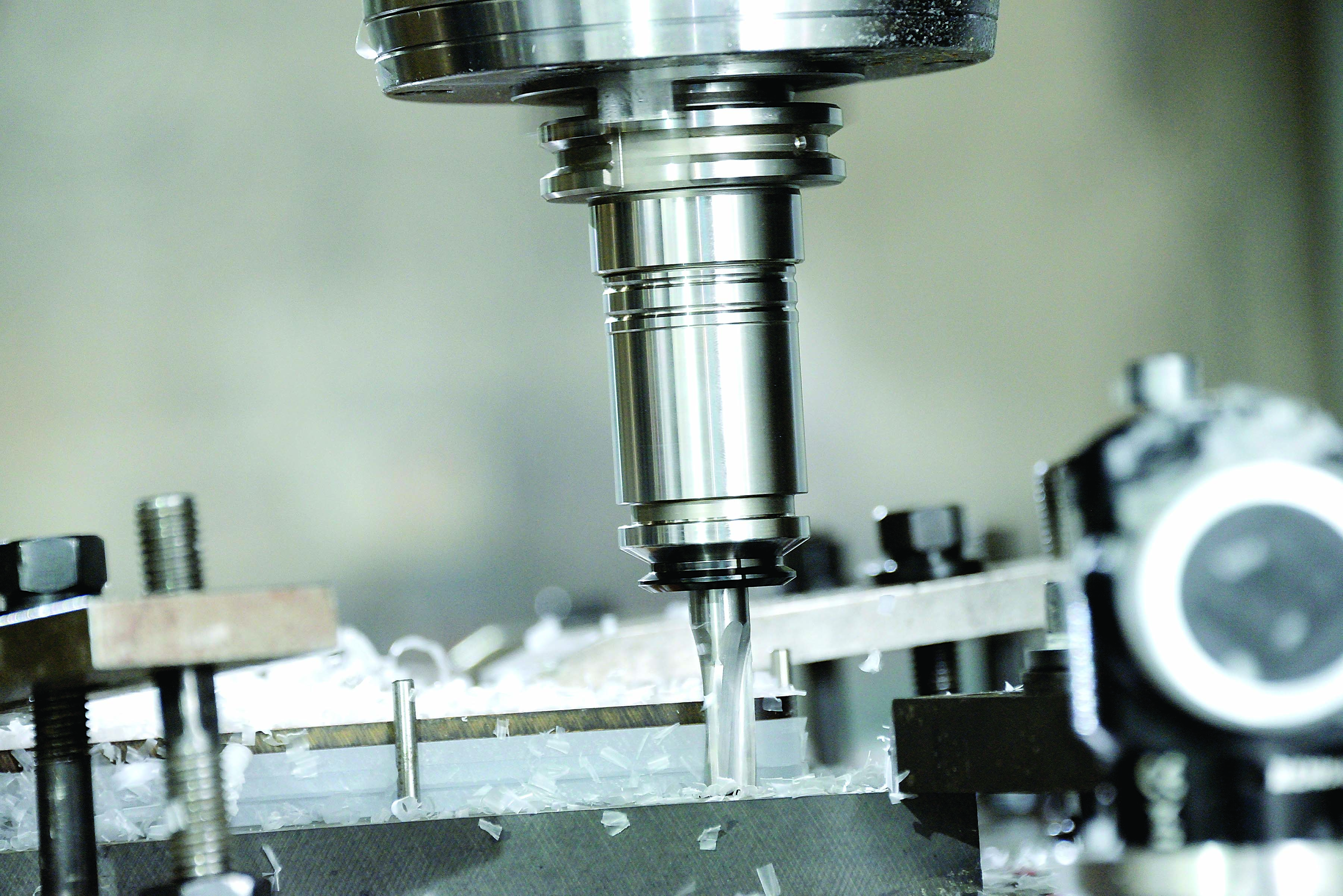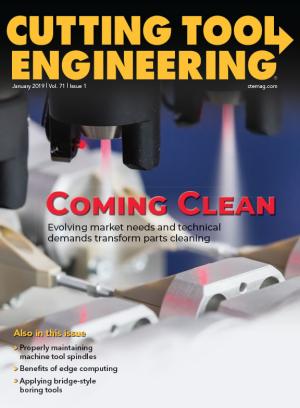Variety may be the spice of life but not when it comes to machining tolerances, where tool runout is the enemy of precision, including when processing plastic parts. Just ask Eric Broderson, president of Bennington, Vermont-based K&E Plastics Inc., which began machining plastics in 1966. For him, runout means increased setup time, compromised part quality, poor tool life and troublesome burrs.
Burrs pose more threats when machining plastics than when machining metal. Most of the techniques typically used to remove burrs from metal materials damage plastic workpieces.
“Deburring plastics can be a nightmare,” Broderson said. “We have a machine out on the shop floor that uses dry ice and compressed air. It freezes the little fibers and then blows them off.” Along with cryogenics, his shop relies on abrasive pads and toolholder-mounted wire brushes.


The powRgrip toolholding system enables K&E Plastics to drastically minimize tool runout when machining plastics. Image courtesy of Rego-Fix Tool
K&E Plastics’ traditional tooling, including standard CAT 40 toolholders with TG 100, yielded runout of about 0.002" to 0.003", which in turn produced burrs. Tool life also suffered, especially on highly abrasive plastics that contained glass fiber. “I could have a 3-flute endmill, but I might only be cutting with one flute because of the runout from the way the tool ran,” Broderson said.
His quest for runout reduction led him to question how his shop held its cutting tools. When Broderson investigated alternatives, he found that many toolholders weren’t a good fit for his company’s workflow.
Meanwhile, K&E was working on a project with another Bennington company. Broderson learned that it had swapped its former toolholder system for one that virtually eliminated runout. Intrigued, he obtained a few of the tools to test on K&E’s equipment and materials, liked what he saw and scheduled a full
demonstration. Instead of 0.002" to 0.003" runout, K&E slashed it to 0.0002" to 0.0003" with the powRgrip System from Rego-Fix Tool Corp., Whitestown, Indiana.
As part of the system, the PGU 9500 automatic clamping unit secures tools in holders in less than 10 seconds without setting parameters or using heat. The system—which also includes powRgrip collet holders, clamping inserts and PG collets—solves K&E’s runout-related problems.
With the press of a button, the powRgrip automatic clamping unit produces a force of up to 9 tons. The pressure fit between collet and toolholder creates a radial force that concentrates on the tool shank through the slotted collet, holding the tool safely and with a high degree of concentricity. This smart system automatically determines clamping pressure based on the clamping insert for a quick, accurate, secure setup that earned Broderson’s immediate commitment.
“The presale demonstration and testing that Rego-Fix’s representative offered allowed us to make the investment much easier,” he said. “Our first purchase order covered probably 30 percent of our milling machine tooling. Eventually, we’ll use Rego-Fix on 100 percent of our milling operations.”
Along with the accuracy that K&E gets, Broderson said the powRgrip System is quick and simple. “It’s very easy to load a holder into the die, put the collet in—done. With Rego-Fix tooling, job changeovers are also much faster.”
With runout significantly minimized, K&E’s machinists can set cutter compensation at zero and use a 0.125"-dia. endmill to create a 0.125" slot. Multiple passes with a 0.093"-dia. tool are no longer needed, reducing cycle times.
“With Rego-Fix tooling precision,” Broderson said, “we’re actually cutting with all three cutter flutes instead of just one, and there is less vibration. This means fewer burrs, so we get a better finished product coming off the machine.”
Part sizes at K&E range from those measuring 0.060" in diameter, which are run on K&E’s screw machines, to others that are 15" in diameter, which are run on the shop’s largest lathe. The range also includes 1" cubes all the way up to 3'-by-4' parts machined in the vertical milling department.
With runout off his list of problems, Broderson has more time to focus on growing his firm in a vibrant economy. Among the productivity advantages of Rego-Fix tooling, he sees one that relates directly to current economic conditions: Reducing cycle times helps K&E accommodate ever-shorter lead times and just-in-time manufacturing.
For more information about how K&E Plastics reduces tool runout, view a video presentation here: cteplus.delivr.com/2dyz9
Contact Details
Related Glossary Terms
- abrasive
abrasive
Substance used for grinding, honing, lapping, superfinishing and polishing. Examples include garnet, emery, corundum, silicon carbide, cubic boron nitride and diamond in various grit sizes.
- collet
collet
Flexible-sided device that secures a tool or workpiece. Similar in function to a chuck, but can accommodate only a narrow size range. Typically provides greater gripping force and precision than a chuck. See chuck.
- concentrates
concentrates
Agents and additives that, when added to water, create a cutting fluid. See cutting fluid.
- cutter compensation
cutter compensation
Feature that allows the operator to compensate for tool diameter, length, deflection and radius during a programmed machining cycle.
- endmill
endmill
Milling cutter held by its shank that cuts on its periphery and, if so configured, on its free end. Takes a variety of shapes (single- and double-end, roughing, ballnose and cup-end) and sizes (stub, medium, long and extra-long). Also comes with differing numbers of flutes.
- flutes
flutes
Grooves and spaces in the body of a tool that permit chip removal from, and cutting-fluid application to, the point of cut.
- gang cutting ( milling)
gang cutting ( milling)
Machining with several cutters mounted on a single arbor, generally for simultaneous cutting.
- just-in-time ( JIT)
just-in-time ( JIT)
Philosophy based on identifying, then removing, impediments to productivity. Applies to machining processes, inventory control, rejects, changeover time and other elements affecting production.
- lathe
lathe
Turning machine capable of sawing, milling, grinding, gear-cutting, drilling, reaming, boring, threading, facing, chamfering, grooving, knurling, spinning, parting, necking, taper-cutting, and cam- and eccentric-cutting, as well as step- and straight-turning. Comes in a variety of forms, ranging from manual to semiautomatic to fully automatic, with major types being engine lathes, turning and contouring lathes, turret lathes and numerical-control lathes. The engine lathe consists of a headstock and spindle, tailstock, bed, carriage (complete with apron) and cross slides. Features include gear- (speed) and feed-selector levers, toolpost, compound rest, lead screw and reversing lead screw, threading dial and rapid-traverse lever. Special lathe types include through-the-spindle, camshaft and crankshaft, brake drum and rotor, spinning and gun-barrel machines. Toolroom and bench lathes are used for precision work; the former for tool-and-die work and similar tasks, the latter for small workpieces (instruments, watches), normally without a power feed. Models are typically designated according to their “swing,” or the largest-diameter workpiece that can be rotated; bed length, or the distance between centers; and horsepower generated. See turning machine.
- milling
milling
Machining operation in which metal or other material is removed by applying power to a rotating cutter. In vertical milling, the cutting tool is mounted vertically on the spindle. In horizontal milling, the cutting tool is mounted horizontally, either directly on the spindle or on an arbor. Horizontal milling is further broken down into conventional milling, where the cutter rotates opposite the direction of feed, or “up” into the workpiece; and climb milling, where the cutter rotates in the direction of feed, or “down” into the workpiece. Milling operations include plane or surface milling, endmilling, facemilling, angle milling, form milling and profiling.
- milling machine ( mill)
milling machine ( mill)
Runs endmills and arbor-mounted milling cutters. Features include a head with a spindle that drives the cutters; a column, knee and table that provide motion in the three Cartesian axes; and a base that supports the components and houses the cutting-fluid pump and reservoir. The work is mounted on the table and fed into the rotating cutter or endmill to accomplish the milling steps; vertical milling machines also feed endmills into the work by means of a spindle-mounted quill. Models range from small manual machines to big bed-type and duplex mills. All take one of three basic forms: vertical, horizontal or convertible horizontal/vertical. Vertical machines may be knee-type (the table is mounted on a knee that can be elevated) or bed-type (the table is securely supported and only moves horizontally). In general, horizontal machines are bigger and more powerful, while vertical machines are lighter but more versatile and easier to set up and operate.
- sawing machine ( saw)
sawing machine ( saw)
Machine designed to use a serrated-tooth blade to cut metal or other material. Comes in a wide variety of styles but takes one of four basic forms: hacksaw (a simple, rugged machine that uses a reciprocating motion to part metal or other material); cold or circular saw (powers a circular blade that cuts structural materials); bandsaw (runs an endless band; the two basic types are cutoff and contour band machines, which cut intricate contours and shapes); and abrasive cutoff saw (similar in appearance to the cold saw, but uses an abrasive disc that rotates at high speeds rather than a blade with serrated teeth).
- shank
shank
Main body of a tool; the portion of a drill or similar end-held tool that fits into a collet, chuck or similar mounting device.
- toolholder
toolholder
Secures a cutting tool during a machining operation. Basic types include block, cartridge, chuck, collet, fixed, modular, quick-change and rotating.
END USER:
K&E Plastics Inc., 802-375-0011, www.keplastics.com
SOLUTION PROVIDER:
Rego-Fix Tool Corp., 317-870-5959, www.rego-fix.com
CHALLENGE:
Significantly reduce tool runout when machining plastics.
SOLUTION:
A tool clamping system that virtually eliminates runout.



